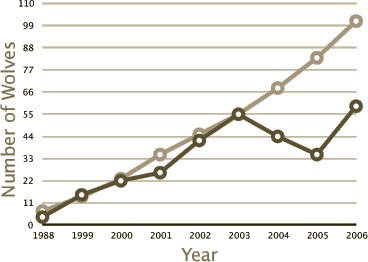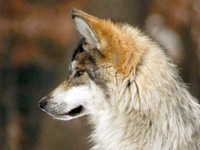Roadmap to Recovery
At the beginning of 2007, there were a minimum of 59 Mexican wolves, including seven breeding pairs, confirmed in the wild. Biologists arrived at this figure by using a helicopter in January to locate and count members of all groups containing radio-collared wolves (biologists counted all collared and visible non-collared members). In addition, field teams utilize howling surveys, observations, and snow-tracking “counts” every December and January to estimate the number of groups without collars. Although 59 is a minimum number, biologists are confident that this is close to the actual number.
The Mexican wolf reintroduction program has undergone reviews in 2001 and 2005, and the U.S. Fish and Wildlife Service determined the reintroduction project would continue. Your input is needed to help determine what changes, if any, need to be implemented as the reintroduction continues.

- Estimated Actual Number of Wolves
- Projected Number of Wolves
Population projections were based on an average litter size of four to six pups. However, data show an average of 2.1 pups per litter in the reintroduced population. Scientists speculate that some pups might die in the den, since pups aren’t counted until leaving it at four to six weeks. Biologists don’t count the pups in the den, because female wolves may relocate or abandon them as a result of the disruption.

Photo Courtesy of the U.S. Fish and Wildlife Service
The Mexican Wolf Recovery Plan population proposal of 100 wolves for the Blue Range Wolf Recovery Area was based on research from other North American wolf recovery areas. However, the terrain is different in the Blue Range Wolf Recovery Area. Year-round grazing means that wolves encounter livestock more frequently, leading wolves to kill more livestock than in other parts of the country. Because of the increased number of depredations, a higher proportion of Mexican wolves are removed from the wild than are gray wolves living in northern climates.

Adult wolves fitted with collars.
Photo Courtesy of Jackie Fallon, Minnesota Zoo
Some of the captive-bred wolves are introduced using a “modified soft release” approach. They are placed in pens of one-quarter acre or smaller. Because they have been raised in captivity, this approach allows the wolves to orient to the wild.

Photo Courtesy of George Andrejko, Arizona Game and Fish Department
Adult wolves are fitted with radio collars before release. Biologists closely monitor the population and produce monthly reports about the wolves and wolf packs, recording information such as pack location, denning sites, and possible depredations.